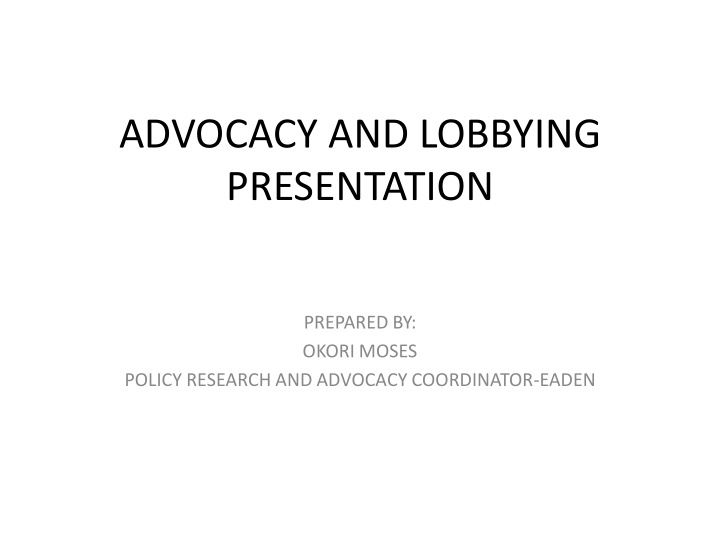



ADVOCACY AND LOBBYING PRESENTATION PREPARED BY: OKORI MOSES POLICY RESEARCH AND ADVOCACY COORDINATOR-EADEN
Definition of advocacy Read the case study presented to you and answer the question, “what is advocacy?” Discuss how you would define advocacy Describe the advocacy strategies used by KAPAH
Definition of advocacy -ctd Advocacy is about: Challenging those in authority to make decisions and change policies, programmes and plans in such a way that they are fair, equitable and favour the disadvantaged and powerless people in the community. • Speaking up or drawing the attention of the local government officials about an issue or problem that affects the community, cause a public debate and finding solutions that lead to change in the existing bad situation
Definition of advocacy-ctd Advocacy is about: Taking action so that those in positions of power or responsibility change their negative attitude and behavior about the poor and disadvantaged people and start treating them as human being like any other person. Developing pro-active strategies and tactics aimed at building the power, clout and energy of the community members so that they are able to claim their rights and entitlements
Targets for advocacy When dong advocacy it is important that you identify the right target with the power and authority to make the decision in your favour. A target is the person or individual in the position of authority at the Sub County or district who can give you the decision you want. Primary target is the person or individual with power and authority in the decision-making chain to give you the ultimate decision Secondary target is a person who while is not the ultimate decision makers but has an influence in the chain of decision making
Steps in successful advocacy There are four key steps which can help your advocacy to be successful: a.Familiarize yourself with the corridors of power – through learning about the rules, processes and people that are most important to your issue b.Classify the Players – knowing your allies, opponents and targets. Both secondary and primary targets need to be targeted.
Steps in successful advocacy -ctd c . Ranking decision-makers – You can use a numbering system to rank decision makers. The numbering system can run from 1 to 5 as follows: Definite supporter of your advocacy demands Potential supporter of your demands Fence sitter (un decided) Likely opponent Definite opponent d. Inform and Build Relationships – Advocacy requires a series of formal and informal one-on-one contacts with decision- makers, and a steady stream of clear, concise back-up information.
Tools for advocacy • Successful advocacy requires that we identify useful tools to do advocacy Following are some of the critical tools that can help create change and social transformation. The media (Radio, Newspaper and Television) Research – good quality research Advance Planning Mobilising and Campaigning Information Dissemination Monitoring and evaluation
Understanding lobbying Lobbying is one of the tactics of advocacy. Lobbying is: the process of trying to influence policy-makers in favor of a specific cause. any activity designed to influence a decision maker to favor or oppose an issue. all attempts to influence directly or indirectly any agency’s activity, and includes any attempt to influence decision makers, their subordinates. An activity of interest groups aimed at influencing government and the public to achieve a favorable policy decisions
Lobbying • Effective “lobbying” requires much more than a communication with a government official advocating a policy position. • It requires substantive knowledge about an issue and the political process and relationships with policy makers. • Everyone can learn the basic skills, but certain personal traits are also important
Lobbyist need to be: • Good listener or observer • Not easily upset or distracted • Willing to let the other person talk and take the lead • Persistent but not resolute • Able to think on your feet • Able to faithfully represent the views of others while still being flexible • Able to say I don’t know • Able to keep a sense of humour • Able to identify concealed agenda • Able to know when to retreat and try a new angle
Practical tips on lobbying an elected Official • Establish your agenda and goals • Listen well • Be prepared, but don't feel that you need to be an expert • Don't stay too long • Follow-up is important • Remember you are there to build a relationship
Ways to Make Your Voice Heard Engagement Written Civil Action expression Participation in Budget Meetings Letters Demonstrations Civil disobedience Participation in barazas/citizens forums Petitions Boycotts Participating in elections through voting Media Public interest Lobby meetings articles litigation Media debates (Radio, TV, Internet, etc) telephone Strikes Whistle blowing calls Citizens arrest Citizen journalism text Summons by messages citizens Recalls
Recommend
More recommend